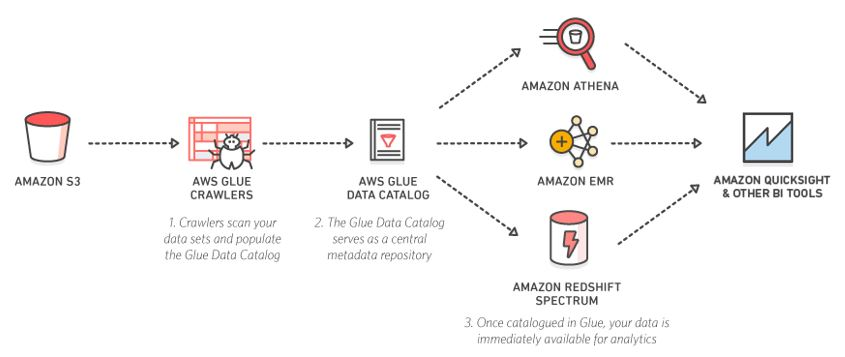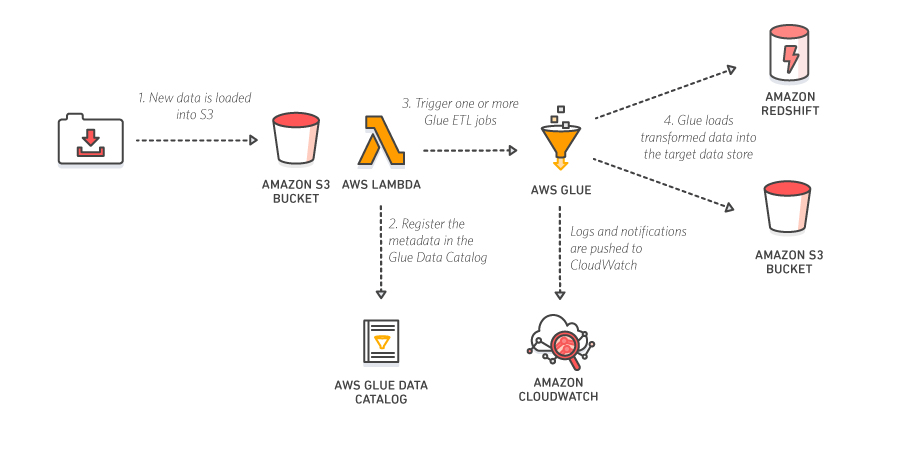AWS Glue is a fully managed extract, transform, and load (ETL) service that makes it easy for customers to prepare and load their data for analytics. You can create and run an ETL job with a few clicks in the AWS Management Console. You simply point AWS Glue to your data stored on AWS, and AWS Glue discovers your data and stores the associated metadata (e.g. table definition and schema) in the AWS Glue Data Catalog. Once cataloged, your data is immediately searchable, queryable, and available for ETL. AWS Glue generates the code to execute your data transformations and data loading processes.
AWS Glue generates code that is customizable, reusable, and portable. Once your ETL job is ready, you can schedule it to run on AWS Glue's fully managed, scale-out Apache Spark environment. AWS Glue provides a flexible scheduler with dependency resolution, job monitoring, and alerting.
AWS Glue is serverless, so there is no infrastructure to buy, set up, or manage. It automatically provisions the environment needed to complete the job, and customers pay only for the compute resources consumed while running ETL jobs. With AWS Glue, data can be available for analytics in minutes.
Ready to start your ETL?
Get Started with AWS Glue
Easy
AWS Glue automates much of the effort in building, maintaining, and running ETL jobs. AWS Glue crawls your data sources, identifies data formats, and suggests schemas and transformations. AWS Glue automatically generates the code to execute your data transformations and loading processes.

Integrated
AWS Glue is integrated across a wide range of AWS services. AWS Glue natively supports data stored in Amazon Aurora, Amazon RDS for MySQL, Amazon RDS for Oracle, Amazon RDS for PostgreSQL, Amazon RDS for SQL Server, Amazon Redshift, and Amazon S3, as well as MySQL, Oracle, Microsoft SQL Server, and PostgreSQL databases in your Virtual Private Cloud (Amazon VPC) running on Amazon EC2. AWS Glue provides out-of-the-box integration with Amazon Athena, Amazon EMR, Amazon Redshift Spectrum, and any Apache Hive Metastore-compatible application.

Serverless
AWS Glue is serverless. There is no infrastructure to provision or manage. AWS Glue handles provisioning, configuration, and scaling of the resources required to run your ETL jobs on a fully managed, scale-out Apache Spark environment. You pay only for the resources used while your jobs are running.

Developer Friendly
AWS Glue generates ETL code that is customizable, reusable, and portable, using familiar technology - Scala, Python, and Apache Spark. You can also import custom readers, writers and transformations into your Glue ETL code. Since the code AWS Glue generates is based on open frameworks, there is no lock-in. You can use it anywhere.
Click to enlarge
First, use the AWS Management Console to register your data sources. AWS Glue will crawl your data sources and construct your Data Catalog using pre-built classifiers for many popular source formats and data types, including JSON, CSV, Parquet, and more.
Click to enlarge
Next, select a data source and data target. AWS Glue will generate ETL code in Scala or Python to extract data from the source, transform the data to match the target schema, and load it into the target. You can edit, debug and test this code via the Console, in your favorite IDE, or any notebook.
Click to enlarge
AWS Glue makes it easy to schedule recurring ETL jobs, chain multiple jobs together, or invoke jobs on-demand from other services like AWS Lambda. AWS Glue manages the dependencies between your jobs, automatically scales underlying resources, and retries jobs if they fail.
Visit the AWS Glue Product Details page, or refer to our product documentation to learn more.
Prepare your clickstream or process log data for analytics by cleaning, normalizing, and enriching your data sets using AWS Glue. AWS Glue generates the schema for your semi-structured data, creates ETL code to transform, flatten, and enrich your data, and loads your data warehouse on a recurring basis.

You can use the AWS Glue Data Catalog to quickly discover and search across multiple AWS data sets without moving the data. Once the data is cataloged, it is immediately available for search and query using Amazon Athena, Amazon EMR, and Amazon Redshift Spectrum.

Data lakes are an increasingly popular way to store and analyze both structured and unstructured data. If you use an Amazon S3 data lake, AWS Glue can make all your data immediately available for analytics without moving the data. Glue crawlers can scan your data lake and keep the Glue Data Catalog in sync with the underlying data. You can then directly query your data lake with Amazon Athena and Amazon Redshift Spectrum. You can also use the Glue Data Catalog as your external Apache Hive Metastore for big data applications running on Amazon EMR.

AWS Glue can run your ETL jobs based on an event, such as getting a new data set. For example, you can use an AWS Lambda function to trigger your ETL jobs to run as soon as new data becomes available in Amazon S3. You can also register this new dataset in the AWS Glue Data Catalog as part of your ETL jobs.

It’s easy to get started with AWS Glue. Simply sign in to the AWS Management Console and navigate to “Glue” under the “Analytics” category.








